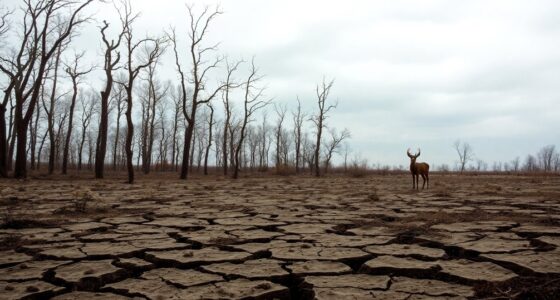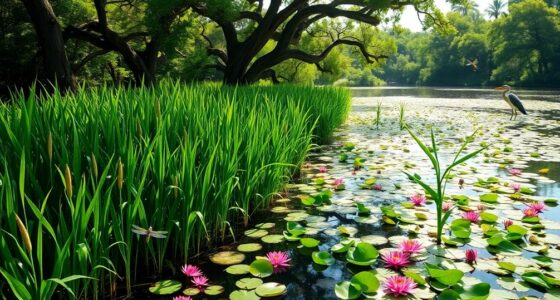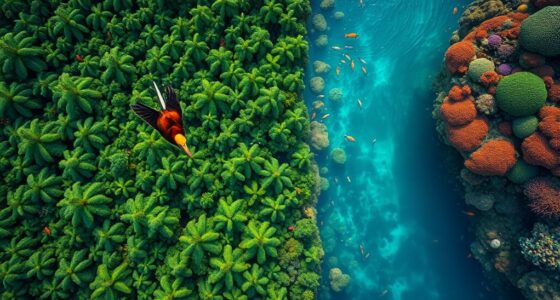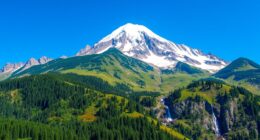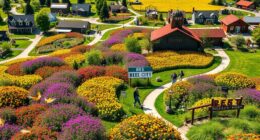Imagine a web of life where every species, from plants to predators, is interconnected in a delicate balance. When one link shifts, it can cause ripple effects throughout the entire ecosystem. Understanding these relationships reveals how ecosystems stay resilient — or become vulnerable. Staying aware of how everything is linked might change how you see the natural world and our role within it. Curious to discover what keeps this web intact?
Understanding the Foundations of Food Webs
Have you ever wondered how different species interact within an ecosystem? Understanding the foundations of food webs helps you see these connections clearly. Food webs show how energy flows through an environment, linking plants, animals, and microorganisms.
At the base are producers, like plants, that make food through photosynthesis. These producers provide energy for herbivores, which in turn are food for carnivores and omnivores. Each species depends on others for survival, creating a complex network.
Recognizing these foundational relationships helps you grasp how ecosystems stay balanced. When one species declines or disappears, it can ripple through the web, affecting many others. This interconnectedness highlights the importance of preserving biodiversity and maintaining healthy ecosystems. Incorporating vetted survival gear and understanding predator-prey dynamics are essential for effective ecosystem management.
The Roles of Producers and Consumers
Understanding the relationships within a food web requires knowing the roles that different species play. Producers, like plants and algae, are at the base; they create energy through photosynthesis, fueling the entire system.
Consumers, on the other hand, rely on producers or other animals for nourishment. Primary consumers eat producers, while secondary and higher-level consumers eat other animals.
Your role as a consumer influences how energy moves through the web. Without producers, there would be no energy source for consumers.
Recognizing these roles helps you see how energy flows and how the survival of one species depends on others. Each species, whether producer or consumer, contributes to maintaining the balance and health of the whole ecosystem.
Additionally, understanding the food web can help you appreciate the complexity and interconnectedness of all living organisms.
Predator-Prey Relationships and Their Balance
Predator-prey relationships are essential for maintaining the balance within a food web. When predators hunt, they control prey populations, preventing any one species from becoming too dominant. This regulation keeps the ecosystem stable, encouraging biodiversity. A celebrity lifestyle can even reflect these natural dynamics, as public figures often adapt to changing circumstances and manage their environments carefully. If prey numbers grow unchecked, they can deplete resources, harming the entire community. Conversely, when predators decline, prey populations may explode, leading to overgrazing or resource depletion. This balance ensures that energy flows smoothly through the ecosystem, supporting various species at different levels. You’ll see this delicate dynamic in action in forests, oceans, and grasslands.
The Impact of Keystone Species
Did you know that some species have an outsized influence on their ecosystems? These are keystone species, and they play a crucial role in maintaining the balance of their environment. When a keystone species is present, it helps regulate population sizes of other species, preventing any one group from dominating. For example, sea otters control sea urchin numbers, protecting kelp forests from overgrazing. If a keystone species disappears, the entire food web can collapse or shift dramatically, leading to loss of biodiversity. You can think of them as the foundation stones that hold the entire structure together. Their presence or absence directly impacts the health and stability of the ecosystem, making them essential for ecological resilience. Additionally, protecting keystone species often involves understanding and supporting environmental considerations, ensuring the long-term health of ecosystems.
How Energy Flows Through the Web
Have you ever wondered how energy moves from one creature to another in an ecosystem? It all begins with the sun, which provides energy that plants absorb through photosynthesis. These plants, called producers, serve as the foundation of the web.
When herbivores eat the plants, they transfer energy to themselves. Predators then hunt these herbivores, passing energy further up the chain. Each transfer isn’t 100% efficient; some energy is lost as heat or used for survival.
This loss limits how many levels the web can support. As you follow the flow, you see that energy continually moves from the sun to producers, then through various consumers, shaping the entire ecosystem.
Understanding this flow highlights just how interconnected and vital each species is. Additionally, diversifying investments and regularly reviewing the investment plan can help ensure long-term sustainability of resources.
The Effects of Disruptions and Species Loss
Disruptions to a food web, such as the loss of a key species, can cause ripple effects that weaken the entire ecosystem. When a top predator disappears, prey populations often explode, leading to overconsumption of plants or smaller animals.
Conversely, losing a primary producer like a vital plant species can reduce food availability for herbivores, impacting predators further up the chain. These changes can destabilize the balance, making the ecosystem more vulnerable to invasive species or environmental stressors.
Each species plays a role in maintaining stability, so their absence can trigger unforeseen consequences. You might notice shifts in population sizes, altered behaviors, or even the collapse of local habitats.
In essence, disrupting one part of the web can threaten the health of the whole system. Additionally, understanding ecosystem resilience can help in developing strategies to mitigate such impacts and protect biodiversity.
Human Influence on Natural Networks
Human activities regularly alter natural networks, often with unintended consequences. When you build roads, clear forests, or farm land, you disrupt existing connections among species. These changes can cause predators to lose prey, plants to lose pollinators, or invasive species to take hold.
For example, introducing non-native species can outcompete local ones, leading to the decline of native populations. Overfishing and pollution also weaken food webs by removing key species or contaminating habitats. Your actions can fragment habitats, reducing species diversity and resilience.
These human influences ripple through ecosystems, sometimes causing collapses or shifts in balance. Recognizing your role is crucial because even small changes can cascade through food webs, affecting the stability and health of entire ecosystems.
Preserving the Integrity of Ecosystems
To effectively preserve the integrity of ecosystems, you need to prioritize actions that maintain natural connections among species and their habitats. Protecting native plants and animals helps sustain the delicate balance that keeps ecosystems healthy. Trust issues with ecosystem components can lead to imbalances that threaten biodiversity and ecosystem stability. Avoid unnecessary development in critical areas, such as wetlands or forests, which can fragment habitats and disrupt food webs. Support conservation efforts and establish protected areas that allow ecosystems to function naturally. Reducing pollution and controlling invasive species also play vital roles in maintaining ecological stability. By respecting natural processes and minimizing human interference, you help ensure ecosystem resilience. Your actions can support biodiversity, prevent species loss, and preserve the complex relationships that underpin the food web. Preserving ecosystem integrity is essential for the health of the planet and future generations.
Conclusion
By understanding how every species connects within a food web, you realize the importance of protecting biodiversity. Your actions can help maintain the balance, preventing disruptions that could lead to ecosystem collapse. Recognizing the roles of keystone species and predator-prey relationships shows how fragile these networks are. By supporting conservation efforts, you contribute to the health and resilience of ecosystems, ensuring they continue to thrive for future generations.

